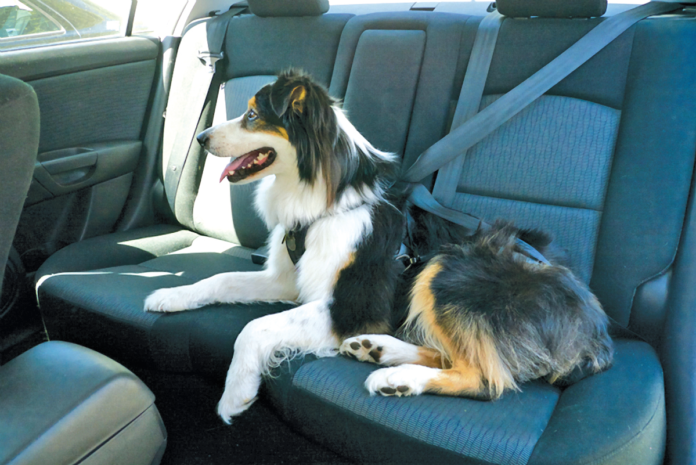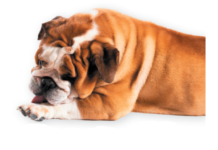Knowing it’s not safe to let your dog wander around the car during road trips, you buckle her into a harness before taking off. Or secure her in a travel crate in the back of the SUV. Or, if she’s on the small side, in a carrier that fits on the back seat. You’re all set now, right?
Wrong. Many harnesses, crates, and carriers are marketed as having been tested for crashes, but often have not actually passed rigorous crash tests — simulations in which artificial dogs of different weights and sizes are put in situations that simulate a crash. Specifically, dog test dummies are moved in car seats down specially designed tracks and observed to see if they stay in place or get knocked about (or fly around) when the car sustains an impact in a staged wreck.
Lindsey Wolko found all this out the hard way when she put her beloved English cocker spaniel, Maggie, into a harness a number of years ago and had to stop short one day on Route 66. Maggie went flying. Even though she was restrained, she wasn’t held in place securely enough and slammed into the back seat, suffering a strained spine and hips that necessitated serious pain killers and kept her from being able to walk up the stairs for a while. Things could have been much worse.
The incident inspired Ms. Wolko to found the non-profit Center for Pet Safety. Based just outside of Washington, DC, in Reston, Virginia, its purpose is to help pet owners “cut through manufacturing marketing hype” and keep their dog — and themselves — safe during car rides. Like a Consumers Union for pet safety in cars, the Center for Pet Safety accepts no funding from makers of pet products. That keeps the organization’s work completely free from industry influence.
Instituting rigorous testing standards
In the wake of Maggie’s injuries, Ms. Wolko learned that there are no federal safety standards for products meant to keep dogs and their owners from harm during auto travel. Manufacturers can claim safety without sufficient proof. That’s why the Center for Pet Safety worked to create rigorous product testing requirements in order for manufacturers to be able to qualify for certification that actually means something. Any product chosen or submitted for safety testing (submissions are voluntary) during simulated crashes is evaluated for the quality of its hardware and stitching and, of course, the apparatus’s ability to hold up and keep a dog safely restrained in the event of an accident. The box on page 4 lists the products that pass muster to date.
Beyond safety ratings
In addition to testing pet products for their level of protection in car accidents (a 60-pound dog hurtling through the air at 35 miles an hour exerts a force of 2,100 pounds upon hitting an object — or another passenger), the Center for Pet Safety offers a number of tips for keeping your dog secure during drives. For instance:
The organization warns against using harness extension tethers, explaining that they treat pets as if they are items on a clothes line. That is, the dog lurches forward and back, impacting its spine in the process and inflicting considerable damage. There have been reports of paralysis and blunt force trauma to dogs. In some cases, a dog’s spine was damaged so severely that the internal organs could no longer function and the pet had to be humanely euthanized.
Many small-dog carriers secured with a seatbelt on the back seat can get crushed in an accident. They don’t have the structural integrity to hold up as the belt pulls on them during impact. Unless the carrier manufacturer can direct you to a crash test video that proves the product will hold up in a crash, your small dog placed in a car carrier is safer on the floor behind the driver or passenger seat.
Pets have to be acclimated to a new safety device. It doesn’t just happen. Use the device on several short trips, increasing the duration of those trips by 5 minutes each time. In addition, use a positive, reassuring, happy voice during the trip and lots of petting and praise when the car ride is over. If your dog responds to treats, give them only when the trip is over to avoid potential car sickness.
There’s also advice for air travelers (if your dog is going to be joining you in the plane’s cabin, remember to pick up a bottle of water for your pet once you are through security); instructions for filing a complaint about a pet product; and more. Surf to centerforpetsafety.org.
Safety Harnesses
Sleepypod Clickit Sport (small, medium, large, extra-large)
Sleepypod Clickit Terrain (small, medium, large, extra-large)
ZuGoPet The Rocketeer Pack
Pet Travel Carriers
Gunner Kennel G1 Small with Strength-Rated Anchor Straps
Sleepypod Carriers
Travel Crates
Gunner Kennel G1 Small with Strength-Rated Anchor Straps
Gunner Kennel G1 Medium with Strength-Rated Anchor Straps
Gunner Kennel G1 Intermediate with Strength-Rated Anchor Straps
* Of 25 products that have been tested so far, the eight listed here have been certified. The Center for Pet Safety uses the maximum weight specified by the pet product brand to ensure a robust crash test. At the end of the test, it takes measurements off of a video along with physical measurements of the product to assess how it held up upon impact. With those measurements in hand, it makes comparisons to its grading scale and awards points for each area of measurement. If the brand has enough points at the end of the test, it is certified with either a 5- or 4-star rating. Anything below those two ratings is “not recommended.” The brand must also agree to significant terms developed in the consumer interest—including transparency if the manufacturer makes any changes (triggering a mandatory retest) other than cosmetic changes like expanding its color options. In addition, companies must continually monitor their quality control and re-certify every 2 years. Finally, the Center for Pet Safety is very strict about the types of marketing language the brands may use.






I wish someone in the US would look at and examine Guardsman from the UK- Heavy duty steel products, expensive and worth every single penny. Crash tested in simulated circumstances with dummy dogs, harnesses can be used as well but, Guardsman IMO, are far safer and kinder to the dog than harnesses alone.. I have seen actual results of (documented) rear enders and T bones which have virtually destroyed the end or sides of a van leaving crates intact and the dogs bruised but not seriously harmed. These aremade to measure for anything small or big time. For their products I looked more to the casual show dog owner or a smaller car since heavy duty crates and for pro handlers or RV traveler are readily available in the US. Each and every crate (personally I have to think Toyota, Jeep and Volvo) has been custom and you pay for the price worth every penny. Each of my crates was hand removeable. If there is anything similar (in the US) with quality and steel, individually manageable, I would appreciate knowing the companies. I personally loathe harnesses.